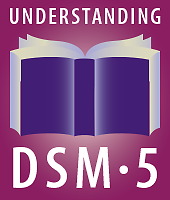Like the DSM-5 published for clinicians in 2013, Understanding Mental Disorders: Your Guide to DSM-5 is organized developmentally, reflecting a “lifespan” approach to the arrangement and explanation of mental disorders.
So naturally the first chapter in the text—to be published in April by American Psychiatric Publishing (APP)—is on “Disorders That Start in Childhood.” These disorders include autism spectrum disorder, attention-deficit/hyperactivity disorder, intellectual disability, communication disorders, specific learning disorder (such as reading, math, or writing problems), and motor disorders (such as tic disorders).
In comments to Psychiatric News, Robert Hales, M.D., editor in chief for books at APP and a member of the six-member editorial advisory panel responsible for the text, said the chapter’s most important passages reflect changes in the way that DSM conceptualizes autism. Those changes—which collapsed previous DSM-IV diagnoses (autism spectrum disorder, Asperger’s, childhood disintegrative disorder, and pervasive developmental disorder not otherwise specified) into a single diagnosis of autism spectrum disorder—were the focus of intense public scrutiny and interest when the clinician’s manual was published.
Also of note is the replacement of “mental retardation” with “intellectual disability,” reflecting changes in the wording used by the federal government and many special education and health care providers.
An excerpt from the text’s description of autism spectrum disorder is illustrative of the straightforward language used throughout the book: “Autism spectrum disorder is marked by two main symptoms: problems with the child’s ability to relate to others and having a fixed set of interests or repetitive behaviors. The disorder name reflects a range, or spectrum, of symptoms that vary greatly by age and person. Many people with the disorder may not be able to handle changes in their daily routines. They may show a lack of eye contact, social response to others, and shared play. Signs of autism spectrum disorder begin during early childhood and often last through a person’s lifetime. Some people with the disorder need a lot of help in their daily lives, and others need less.”
As with all disorders outlined in the book, Understanding Mental Disorders: Your Guide to DSM-5 discusses risk factors and treatment options associated with autism spectrum disorder and also provides an illustrative patient story describing a real patient (using a pseudonym and removing any identifying information) with the disorder (see box).
The chapter also addresses the belief—prevalent among some in the public but roundly disputed by much research—that childhood vaccines cause autism spectrum disorder. The book states, “One reason people believe that autism spectrum disorder is linked to vaccines is that the signs of the disorder sometimes do not appear until around the same age the measles, mumps, and rubella vaccine is given. If a child is diagnosed shortly after getting the vaccine, this may seem like the vaccine caused the disorder. Many studies have found no proof of a link between autism spectrum disorder and vaccines. … Parents are strongly urged to have their child immunized to protect against serious childhood diseases.”
The chapter on childhood disorders is followed by one on psychotic disorders—schizophrenia, schizoaffective disorder, delusional disorder, brief psychotic disorder, schizophreniform disorder, and catatonia. The chapter emphasizes the serious nature of psychotic disorders and the need for early identification and early treatment with antipsychotic medication and a variety of other supportive therapies: “Schizophrenia and other psychotic disorders are serious illnesses that disrupt how someone thinks and understands what he or she sees or hears. These disorders involve a psychosis: symptoms that make it very hard or impossible for a person to know what is real, to think clearly, to communicate and relate with others, and to feel normal emotions. When these symptoms occur, it can be hard to get through to the person or to understand what he or she is trying to say. With treatment, many people with these disorders do get better and can work and live on their own.”
Illustrative of the “user-friendly” approach throughout the book are the “Medication Tips” for patients taking antipsychotic medication. Those tips include points such as take the medication as the physician directs, know what to expect with side effects (weight gain or fatigue may be common side effects with some medications), and do not stop a medication right away or decrease the dose without checking with a doctor first. The “tips” column also notes that “medicines can cause health changes over time (for instance, in cholesterol, blood pressure, and blood sugar). Any of these problems can be handled safely as long as you see the doctor regularly.”
The third chapter in Understanding Mental Disorders: Your Guide to DSM-5 is on bipolar disorders—bipolar I, bipolar II, and cyclothymic disorder.
Each chapter in the book concludes with “key points” that summarize the most important “take-away messages” about a disorder. Here are the key points for bipolar disorders:
•
People with bipolar disorders have extreme and intense moods (for instance, switching between being very happy and active and feeling very low and out of energy). These are unlike the normal ups and downs in mood that occur in daily life.
•
People with these disorders may feel out of control or ruled by their extreme moods and behaviors. The disorder can damage relationships, cause problems with work or school, and even lead to suicide.
•
The bipolar disorder class includes three conditions: bipolar I, bipolar II, and cyclothymic disorder. They share many of the same symptoms but differ in severity and intensity, and thus they need somewhat different treatment.
•
Although these disorders are lifelong, they are very treatable. People with these disorders benefit most from a combination of medications, psychotherapy (“talk therapy”), and healthy lifestyle habits. With the right treatment, people with bipolar disorders can lead full and productive lives.
Symptoms improve and can change over time, so keeping in touch with a mental health care provider will ensure that treatment best suits the person and his or her life and needs. ■
More information on
Understanding Mental Disorders: Your Guide to DSM-5 can be accessed
here. APA members may purchase the book at a discount
here.

